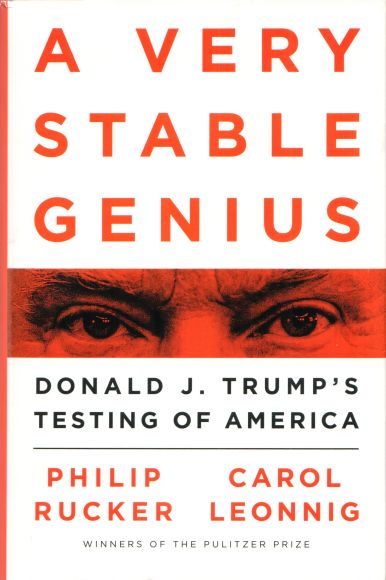

| A VERY STABLE GENIUS Donald J. Trump's Testing of America Philip Rucker & Carol Leonning New York: Penguin Press, January 2020 |
Rating: 5.0 High |
|||
| ISBN-13 978-1-9848-7749-9 | ||||
| ISBN-10 1-9848-7749-6 | 465pp. | HC | $30.00 | |
What single story shows Trump's utter incapacity for the presidency? His reign of error is, in military terms, "a target-rich environment." Prominent examples are the tariff wars, his persistent campaign to repeal "ObamaCare" with nothing to replace it, and of course his bungling of the reponse to the 2020 pandemic.
But, I submit, his ongoing mismanagement of the southern border takes the booby prize. Springing from his bigotry against Latinos and his need for a boogeyman, it became his top campaign issue and led him to promise, ludicrously, that Mexico would pay for the "great, great wall" he would build along the border to keep out the people he said were bringing drugs and crime into America. In addition to misreading his ability to compel Mexico's government, he failed to grasp the magnitude of the task itself or the difficulty in getting Congress to fund it. The authors cover parts of this story. On pages 35-38, they tell how Tillerson and Kelly flew to Mexico City to smooth over the outrage caused by Trump's threat of tariffs on Mexican exports to the U.S. if the country did not agree to pay for the wall. The very day they were to meet with their Mexican counterparts, Trump in Washington tweeted a threat to send troops to the border to expel the "gang members" and "drug lords." Despite this new bombshell, Tillerson and Kelly succeeded in their mission.
Progress was slow during his first two years in office, when the GOP controlled both houses of Congress. He did issue an executive order directing Homeland Security to begin the process. But many Republicans in Congress were skeptical about spending so much money ($21B, triple Trump's estimate) without offsetting the cost somehow. The Army Corps of Engineers (ACE) began pre-construction work in July 2017, and in August four companies were selected to build prototypes. Many owners of property near the border began to object to the plans, and activists filed suits after DHS waived environmental reviews.
Construction of wall segments began in February 2018 on a two-mile stretch near Calexico. It was followed by two longer stretches. In June, the prototypes were found inadequate. At the end of 2018, with Democrats set to take back the House, Trump requested $5.7 billion in funding for 234 miles of barrier. He didn't get it, and shut the government down for 34 days to force Congress's hand. It didn't work; Congress offered $1.4 billion (close to their original offer), and Trump caved. Then it was found that all prototypes could be breached with common tools. Trump's next ploy was to declare a national emergency over the migrant "invasion" and shift already allocated money from other projects such as improved housing for military families. (A lower court shut down use of military funds, but the Supreme Court reversed it in July 2019. Another injunction against military funds issued in December.)
Construction continued in fits and starts through 2019 amid mounting legal challenges by contractors and activists. A private group, We Build the Wall, raised $23 million and moved ahead with plans to build a 1-mile wall on private land despite a cease-and-desist order. Customs and Border Protection said in a July 11 statement that, despite 205 miles of wall being funded, only run-down older sections had been replaced. Not one mile of new wall had been built.
The second injunction against military funding was lifted in January 2020. In February, a district court blocked use of funds diverted from a submarine base, and on 2 March three organizations teamed up to block military funding in general. They were joined the next day by attorneys general of 19 states. In April, defying demands to spend more on battling the pandemic, Trump pledged an additional $569 million for wall construction.
Various groups demonstrated the weaknesses of the "steel bollard design" wall segments, cutting a gap in 20 minutes wide enough to squeeze through, or simply scaling the wall. Meanwhile a section too near the Rio Grande was washed out during a flood. Trump demanded webcams installed so construction progress could be watched by the public, and continued to propose absurd improvements: putting solar panels on the walls, electrifying them, building a moat filled with alligators, and recruiting enough people to form a continuous line of guards.1 Meanwhile punitive measures blocked asylum seekers from the normal crossing points, so in desperation they tried to come overland. Arrests surged, overtaxing CBP resources and leading to human-rights abuses that the books America Is Better than This by Senator Jeff Merkley and Separated by Jacob Soboroff cover very well.

 To contact Chris Winter, send email to this address.
To contact Chris Winter, send email to this address.